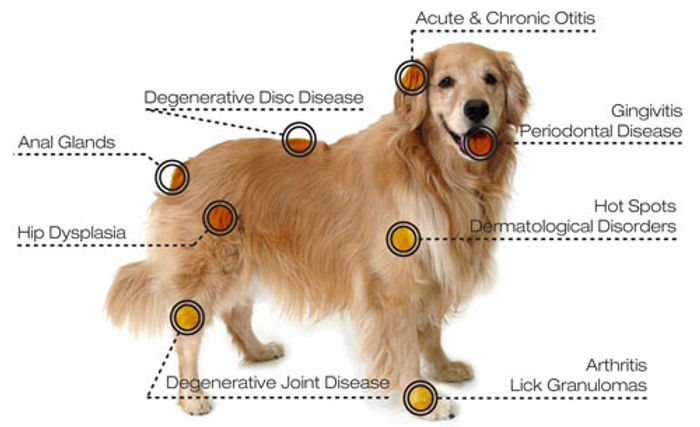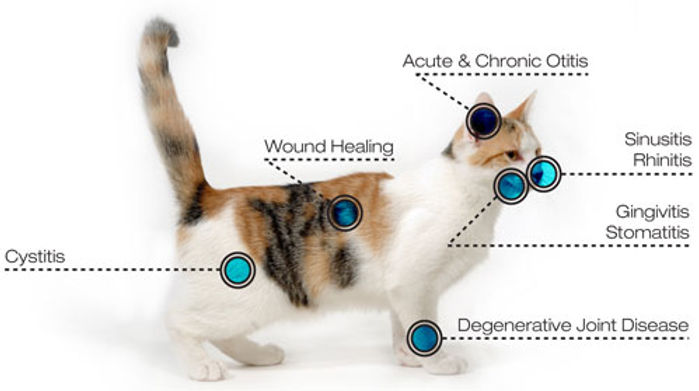Laser Therapy
Consider it the “non-cutting” edge of veterinary science! Laser therapy is an innovative technology used to treat acute and chronic injuries. This non-invasive treatment stimulates cell regeneration by increasing blood flow to the targeted area, which accelerates the healing process. It has been successfully used to accelerate the healing process after surgery, alleviate joint pain, and treat degenerative diseases.
What is Therapeutic Laser?
Low-level or “cold” laser therapy focuses red and infrared light on tissue at and below the surface of the skin. The light energizes the cells, producing a structural protein called collagen used to repair tissue. Lasers continue the healing process by supporting vascular dilation and synthesis, increasing blood circulation to the affected region. The stimulation also releases the body’s own pain-relieving hormones.
The word “laser” originated as an acronym for light amplification by stimulated emission of radiation. Laser light is different from “normal” light because it is of a single wavelength and it is focused (concentrated). The wavelength influences the biological effects of the therapeutic laser and is measured in nanometers (nm). The wavelength also determines the depth of penetration into the body’s tissues. Most medical laser applications use light wavelengths ranging from visible red to infrared. The shorter, visible wavelengths penetrate tissue to a shallower depth, whereas longer, infrared wavelengths penetrate deeper into tissue.
The process generally takes between 5-10 minutes, with most patients seeing positive effects after 3-5 uses. The treatment continues to relieve pain and fight inflammation for up to 24 hours following the session.
How Does Therapeutic Laser Work?
Photobiomodulation (the laser-tissue interaction) creates many consequences in the body’s cells, with the most significant being reduction of pain and enhancement of healing. For example, therapeutic laser reduces pain by decreasing inflammation, as well as by decreasing tissue chemicals that stimulate pain and by affecting nerve conduction. Therapeutic laser also enhances healing by increasing microcirculation (blood flow through the smaller blood vessels of the body), stimulating cellular activity, and increasing growth factors.
Therapeutic Laser Reduces Pain and Enhances Healing
The laser light is delivered through a noninvasive handpiece to treat the affected area. Your pet may feel a gentle and soothing warmth. Most treatments take a matter of minutes. Treatments vary in time and frequency and can be used to enhance other treatment plans recommended by your veterinarian, such as post-surgery healing.
What Types of Conditions Benefit from Therapeutic Laser?
- Hip dysplasia
- Post-surgical incisions and soft-tissue trauma
- Arthritis and degenerative joint disease
- Musculoskeletal injuries
- Neuromuscular disease
Applications


Acute Conditions
Wounds, allergies, infections, cuts/bites, inflammations, tooth extraction pain relief, sprains, strains, fractures, post-surgical healing and pain relief.
Chronic Conditions
Degenerative joint disease, inflammatory bowel disease, periodontal disease, lick granulomas, geriatric care, hip dysplasia, feline acne, tendonitis, arthritis, otitis, and more.
Are All Therapeutic Lasers the Same?
Therapeutic lasers are not all the same. The two classes of therapeutic laser in common use are class III and class IV. Class III therapeutic lasers are lower powered and typically use shorter wavelengths. Class IV therapeutic lasers are higher powered and use longer wavelengths. Different powered lasers will take different amounts of time to deliver the treatment dose of light energy. A higher-power laser translates to a shorter treatment time overall.
How is the Dose of Light Energy Calculated? How is it Delivered to the Patient?
The therapeutic laser dose is expressed in joules of energy delivered at the skin surface. The dose is calculated by taking into consideration the type of laser equipment being used, the surface area of the affected body part, and the size of the patient. The dosage to treat deep tissues largely depends on patient size; for example, the bigger and bulkier the patient, the higher the concentration of energy needed. The laser dosage for treating superficial conditions is more consistent for many patients, regardless of size.
Once the dose of laser energy at the surface is determined, the surface area over the tissue to be treated is measured. With class III therapeutic lasers, the laser handpiece is typically moved around the area to be treated in a grid pattern; the handpiece remains in each spot until a certain number of joules of energy are delivered. The higher-power density of a class IV therapeutic laser means that the handpiece should remain in fairly constant motion, “painting” the surface of the treatment area in a systematic pattern.
Does My Pet Have to Be Shaved to Receive Therapeutic Laser?
Unlike therapeutic ultrasound, therapeutic laser does not require shaving the hair over the area to be treated.
How Long does a Therapeutic Laser Treatment Last?
The length of a therapeutic laser treatment depends on the total dose of light energy to be delivered and how quickly the laser can deliver that energy. For instance, a class III laser might require treatment lasting 20 minutes or more, while a class IV laser might only require a few minutes.
How Often Will My Pet Need Therapeutic Laser? How Many Treatments Can I Expect?
Most patients receiving therapeutic laser are treated two to five times per week for several weeks. Acute issues are generally treated more frequently but over a shorter time frame, while chronic conditions tend to be treated less frequently but for a longer overall time frame.
Are There Any Reasons Not to Use Therapeutic Laser on a Pet?
Therapeutic laser should not be used over areas of active bleeding or over the eyes, testicles, tumors, pregnancies, or growth plates in the bones.
(Some information and images for this article taken from LiteCure’s “Heal Your Pet with Laser Therapy” handout)
Laser therapy is normally combined with other types of veterinary medicine including pharmaceutical regimens and alternative treatments. The broad biochemical benefits and lack of adverse side effects have made laser therapy the preferred post-operative rehab method in veterinary medicine.
Laser Therapy for Pets in Michigan City, IN
If you would like to know more about laser therapy and if it could benefit your pet, contact us at 219-872-4191.
Explore Our Complete List of Veterinary Services in Michigan City, Indiana
- Laparoscopic Surgery
- Echocardiography
- Exotic Pets
- Regenerative Medicine
- Physical Rehabilitation
- Ozone Therapy
- Afterhours Telemedicine
- Acupuncture
- Electrocardiography
- Radiology
- Laboratory
- Ultrasound
- Hospice Care
- Spay & Neuter
- Vaccinations
- Parasite Prevention
- Wellness Exams
- Dental Care
- Surgery
- Grooming
- Boarding
- Emergency and Urgent Care
